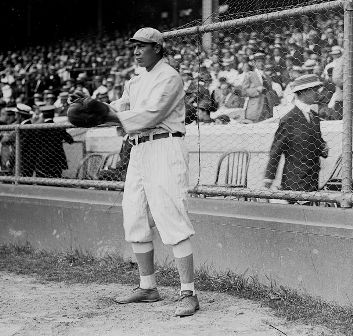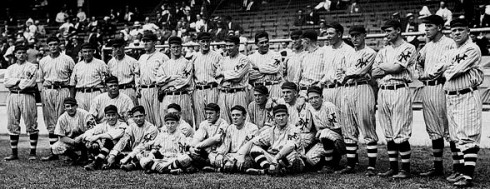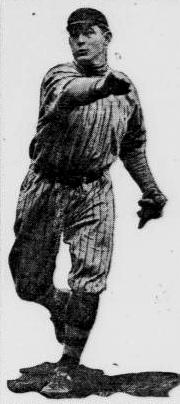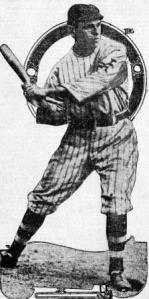As the New York Giants were cruising to the National League Pennant in 1912—they won by 10 games and were never in second place after May 20—New York’s catcher John “Chief” Meyers provided fans with a look at life with the Giants.
The article was written for The Associated Press—most likely by Jim McBeth of The New York American, who acted most often as Meyers’ ghostwriter:
“After the last ball of the game is fielded and the crowd begins to pour out of the park and the players disappear into the clubhouse—what then?
“The fans read in their papers next morning: ‘New York at Pittsburgh’ or ‘New York at Boston,’ or something like that. And until the bulletin boards begin to put up the score, inning by inning, in the afternoon, they know little of nothing about the men they have been watching and cheering.
“What have ballplayers been doing in the meantime?”
Meyers explained life on the road:
“Well, suppose we’ve just finished a game on the Polo Grounds. Our schedule calls for a battle with the Pirates in their home park. Of course, the first thing is to get there, and we get there in easier and better fashion than any other sort of a traveler.
“We have two private Pullman cars of our own, always, and they are our traveling home We assemble at the railroad station—sometimes forty strong—and just pile aboard and make ourselves comfortable.
“In the first place, I might mention the make-up of our party. We carry twenty-five players, as many as the rules allow; John McGraw, the manager; Wilbert Robinson, coach and assistant manager; the club secretary and his assistant; Dr. Finley the club physician; Ed Mackall, the club trainer; Dick Hennessy, our kid mascot, and as many as ten or twelve newspaper writers especially towards the end of a close race.”
As for accommodations:
“If he is a regular he takes possession of a seat which indicates that his berth when it is made up will be a ‘lower.’ That’s an absolute rule. Nothing but the cream for the first string players.
“As soon as the train pulls out the boys go to their favorite amusements—card playing, reading, ‘fanning.’ Don’t think a player finishes a game when he sheds his spangles. He doesn’t. Many a game is played all over again as soon as the boys get together.
“There’s a little quartet of us who are pinochle fans—(James ‘Doc’) Crandall, (Art) Fletcher, (David ‘Beals’) Becker and myself—a fine lot of Dutchmen we are. We’re the ‘tightwads’ of the club because we don’t risk as much as a nickel on our games.
“There was a time when there was tall gambling by the players on trains while traveling from one town to another. I’ve seen as much as $6,000 or $7000 on the table in a poker game. But that’s past; the player of today holds on to his money, and, besides, he knows that high betting causes ill feeling between friends and heavy losses get a man’s mind off his playing. The Giants play a little poker, of course, but it’s only a 25-cent limit game, where a man in hard luck may lose as much as $4 or $5 in a session.
“Occasionally you’ll hear a little singing. Some of the boys have really good voices. Others fancy themselves as vocalists, anyhow. Larry Doyle, for instance…Leon Ames gets up sometimes and gives us his specialty. He recites Kipling’s poem, ‘On the Road to Mandalay,‘ (with an affected speech impediment). That always gets a laugh. The younger, smaller players buzz around Big Jeff Tesreau like a flock of mosquitoes attacking an elephant, giving him a good-natured kidding until he sweeps his big arms and chases them. “
Meyers said the Giants were “like one big family—a lively, noisy bunch of pals.” He said a player occasionally “gets a grouch and sits off by himself,” but:
“I never saw a group of men in any business so genuinely attached to each other…Occasionally some stranger tries to horn into our cars but he quickly finds he isn’t wanted.”
The Giants, he said, drew crowds at the ballpark and at their hotel:
“There’s nothing tight about us when we travel. We’re an attraction and we know it, and that helps box office receipts. People always want to see this club that’s got Matty and a real Indian, and sometimes (the previous season) Charley Faust or a Bugs Raymond as an added attraction. So we don’t keep our light under any bushel.
“We’re always pretty well sized up in our hotel in a strange city. We can hear people say ‘So they are the Giants eh?’ The native can always spot me because of my Indian appearance, so I’m usually the one they make for.
“’Say, Chief, which is Matty?’ they ask. ‘Which one is Johnny McGraw?’ ‘Who’s going to pitch today, Chief?’ The other boys give me the laugh because I’m the goat for all questioners. The fans don’t recognize the other players.”
Meyers said most of the Giants were not great dressers, ‘content with two changes of costume.” The exceptions were Rube Marquard: “He travels with a steamer trunk and sometimes has six or eight suits with him,” as well as Josh Devore and Art Wilson.
Meyers said every player shared one fashion statement:
“Everybody…sports a diamond. That seems to be the badge of big-league class. As soon as a ballplayer gets out of the ‘bushes’ and into the big show the first thing he does is buy a spark. Some of the boys have half a dozen. “
Meyers also insisted that drinking was not a problem among the modern players:
“One thing we hear from strangers most frequently is ‘Have a drink, old man let’s drink one for good luck in today’s game.’ That invitation is invariably refused. Few of the boys drink anything at all, and those who do take a glass of beer occasionally do it among themselves always. The present day player differs greatly from the old timer, who mixed with everyone.
“Pleasant strangers, with sensible questions, we don’t mind, but they are in the minority t the butters-in who simply want to tell their friends they are associates of ballplayers.”
Meyers said he and his teammates were also very popular with deaf fans, many of whom began following the Giants when Luther “Dummy” Taylor (1900-01, 1902-08) pitched for the club:
“(N)ow they’re friends of all of us. Most of the Giants learned the finger talk from Taylor.”
He said Mathewson, Doyle and Fred Snodgrass were all very conversant in sign language and “are the idols of” many deaf fans.
Meyers frequented art museums on the road. As for his teammates: billiards for most, chess or checkers for Mathewson during the day, and the theatre at night, he said, were the “favorite pastimes” of the Giants.
No matter the activity after a road game, he said: “Everybody must be in bed” by 11:30 pm. “That’s one of McGraw’s rules, and the boys are on their honor to obey it.”
Meyers drew one conclusion from the lifestyle of the modern ballplayer. He and his brethren were “(A) trifle better off, both physically and morally, than the average young man.”






Leave a comment